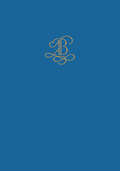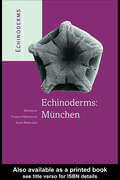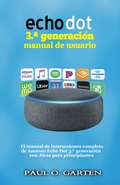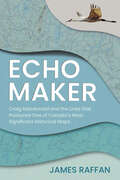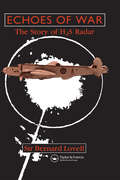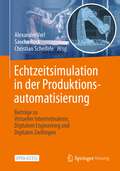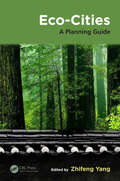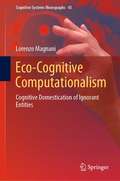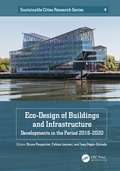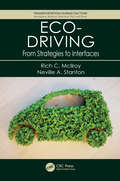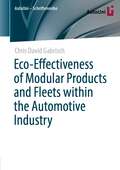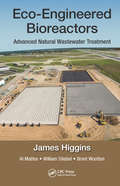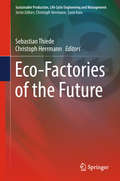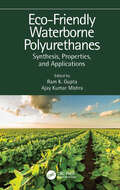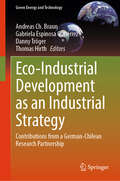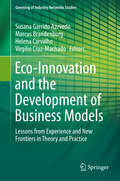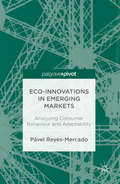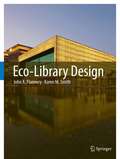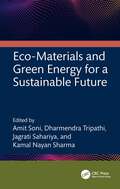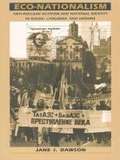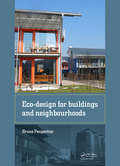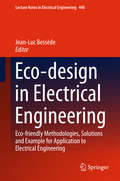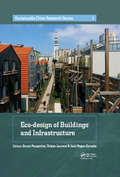- Table View
- List View
Echinoderms: Present and Past
by Michel JangouxThis book is an outcome of the European colloquium on Echinoderms held at Brussels in 1979. It is divided into three major sections: paleontology, skeletal structures, and systematics and zoogeography. The book is useful for zoologists, scientists in zoology, and academics.
Echinoderms: Proceedings of the 11th International Echinoderm Conference, 6-10 October 2003, Munich, Germany
by T. Heinzeller J. H. NebelsickSince 1972, scientists from all over the world working on fundamental questions of echinoderm biology and palaeontology have conferred every three years to exchange current views and results. The 11th International Echinoderm Conference held at the University of Munich, Germany, from 6-10 October 2003,continued this tradition. This volume
Echo Dot 3.ª generación manual de usuario: El manual de instrucciones completo de Amazon Echo Dot 3.ª generación con Alexa para principiantes
by Paul O. Garten¿Qué tal vivir a cuerpo de rey, tan solo haciendo solicitudes, sentándote y viendo cómo se llevan a cabo al pie de la letra? Entonces, ¡no te lo pienses más! Ese es el trabajo de Alexa y lo hace como nadie. Lo que Alexa puede hacer depende de cómo la entiendas y, especialmente, cómo entiendes su lenguaje. Sí, Alexa no solo entiende las palabras, sino que comprende una serie de códigos que no se corresponden exactamente con cómo hablamos en nuestro día a día. El libro trata detalles que van desde operar con Amazon Echo Dot (3.ª generación) hasta la manipulación del dispositivo, como, por ejemplo, Entrenamiento de voz con Alexa. Entender los estados del anillo de luz. Conectar el Echo Dot a Internet. Emparejar el altavoz/stereo con Bluetooth Cambiar la palabra de activación. Configurar el Echo Dot en diferentes localizaciones dentro de tu hogar. Configurar alarmas y temporizadores, hora y fecha. Gestionar email y SMS. Skills, Rutinas y Blueprints de Alexa. Llamadas de voz/vídeo con Alexa. Controlar tu TV con Alexa. Hacer que Alexa lea un ebook de Kindle por ti. Vincular tu Calendario. Comprar con Alexa. Eliminar grabaciones de voz del historial de Alexa. Construir un Hogar digital con Alexa. Protocolos IFTTT con Alexa. Jugar con Alexa. Alexa para Niños. Resolver problemas comunes con tu Amazon Echo Dot y Alexa. Y mucho más. Sí, hay más de 100 comandos de voz y más de 100 perlas de Alexa esperándote dentro de tu dispositivo Echo Dot (3.ª generación). No tienes que gastar cientos de euros para tener un asistente personal avanzado como Alexa. Invirtiendo poco tiempo para configurar tu Echo Dot (3.ª generación), conseguirás muchas funcionalidades para tu hogar y hará tu vida más fácil e interesante.
Echo Maker: Craig Macdonald and the Lives that Produced One of Canada's Most Significant Historical Maps
by James RaffanIn an example of truth and reconciliation put into practice, Craig Macdonald spent decades creating a unique map of Temagami, developed through trust and experience, in partnership with the Teme-Augama Anishnabai. James Raffan’s biography of Craig Macdonald and how the Historical Map of Temagami came to be is a remarkable tale. In the mid-1960s, Macdonald began interviewing and travelling with Indigenous trappers and travellers. He became familiar with Anishinaabemowin and built a lasting bond with the traditional knowledge holders. Returning year after year to map the land, Macdonald painstakingly plotted traditional placenames, original shorelines, elevations, and traditional summer and winter travel routes — including the documentation of more than twelve hundred canoe portages and winter snowshoe trails. His map is unique in the Canadian cartographic canon, and its genesis is a story that has never been told, until now.
Echoes of War: The Story of H2S Radar
by Bernard LovellThis book presents a passionate first-hand account of the development of the Home Sweet Home (H2S) radar systems during World War II. It provides numerous personal insights into the scientific culture of wartime Britain and details the many personal sacrifices, setbacks, and eventual triumphs made by those actively involved. Sir Bernard Lovell led the group that developed the H2S radar system to identify towns and other targets at night or during heavy cloud cover. H2S was successful during the attack on Hamburg in January 1943 as well as the air war against U-boats in the Bay of Biscay.
Echtzeitsimulation in der Produktionsautomatisierung: Beiträge zu Virtueller Inbetriebnahme, Digitalem Engineering und Digitalen Zwillingen
by Alexander Verl Sascha Röck Christian ScheifeleDieses Open Access Buch befasst sich in 22 Kapiteln von 41 Autoren aus Wissenschaft und Praxis mit einer Sammlung unabhängiger Beiträge, die den heutigen Stand der Forschung und Technik im Bereich der Echtzeitsimulation von Maschinen und Anlagen aufzeigen. Neben Forschungsergebnissen wird der erfolgreiche Transfer in die Praxis anhand ausgewählter Beispiele vorgestellt. Das Sammelwerk umfasst das Themenspektrum von der Echtzeitsimulation für die Virtuelle Inbetriebnahme über deren Einsatz in der Entwicklungs- und Betriebsphase bis hin zur Nutzung von Simulationsmodellen in Steuerungsfunktionen.
Eclipse Chaser: Science in the Moon's Shadow (Scientists in the Field Series)
by Ilima LoomisThe August 2017 solar eclipse is the chance of a lifetime for astronomer Shadia Habbal—years of planning come down to one moment of totality. Will everything go off as planned? On August 21, 2017, much of America stood still and looked up as a wide swath of the country experienced totality—a full solar eclipse. Even in areas outside the path of totality, people watched in awe as the moon cast its shadow on the sun. For most, this was simply a once-in-a-lifetime experience. Not so for Shadia Habbal, who travels the world in search of solar eclipses in order to study the sun&’s corona. Solar wind and storms originating in the corona can have big effects on our planet. They can disrupt technology, expose aircraft to radiation, and even influence global climate change. In the months leading up to the 2017 eclipse, Shadia assembles a team of scientists to set up camp with her in Mitchell, Oregon. Years earlier, a long, expensive trip to Indonesia to study an eclipse failed when the skies remained too cloudy to see it. Shadia is determined to have the 2017 eclipse be a success. Will the computers fail? Will smoke from nearby fires change direction? Will the cloudy skies clear in time? Readers will be on the edge of their seats as they count down the months, days, hours, and finally minutes until totality.
Eco-Cities: A Planning Guide (Applied Ecology and Environmental Management)
by Zhifeng YangAs cities undergo vast changes due to industrialization, urbanization, and globalization, environmental considerations assume a growing importance in the urban planning processes of an increasing number of governments around the world. Several cities and regions around the world have already enacted policies that signal the emergence of a paradigm
Eco-Cognitive Computationalism: Cognitive Domestication of Ignorant Entities (Cognitive Systems Monographs #43)
by Lorenzo MagnaniThis book mainly focuses on the widely distributed nature of computational tools, models, and methods, ultimately related to the current importance of computational machines as mediators of cognition. An entirely new eco-cognitive approach to computation is offered, to underline the question of the overwhelming cognitive domestication of ignorant entities, which is persistently at work in our current societies. Eco-cognitive computationalism does not aim at furnishing an ultimate and static definition of the concepts of information, cognition, and computation, instead, it intends, by respecting their historical and dynamical character, to propose an intellectual framework that depicts how we can understand their forms of “emergence” and the modification of their meanings, also dealing with impressive unconventional non-digital cases. The new proposed perspective also leads to a clear description of the divergence between weak and strong levels of creative “abductive” hypothetical cognition: weak accomplishments are related to “locked abductive strategies”, typical of computational machines, and deep creativity is instead related to “unlocked abductive strategies”, which characterize human cognizers, who benefit from the so-called “eco-cognitive openness”.
Eco-Design of Buildings and Infrastructure: Developments in the Period 2016–2020 (Sustainable Cities Research Series #4)
by Bruno Peuportier Fabien Leurent Jean Roger-EstradeThe Chair Eco-design of buildings and infrastructure, a partnership between three engineering colleges (MINES ParisTech, Ecole des Ponts ParisTech and AgroParisTech) and the VINCI group, aims to create measurement and simulation tools which integrate all the dimensions of eco-design (greenhouse gas emissions, impact on biodiversity and resource levies, etc.) to become real decision-making tools, based on a scientific approach, for all actors in the city (designers, builders and users). This book reviews the second five-year sequence of the Chair, first presenting methodological advances in eco-design: life cycle assessment and quantification of uncertainties; local environmental impacts of transport and biodiversity. The interdisciplinary partnership, also associating the human sciences, shows its interest in taking into account the human factor in the modelling of urban systems. This modelling is based on several numerical simulation tools, presented in the third part. This theoretical set results in more substantial proposals for the renewal of techniques and systems, in terms of energy management strategies in buildings, urban agriculture, participatory data collection and digital transformation in transport. This book is intended for urban planners, local authorities, building owners, architects, design offices, companies, building managers, teacher-researchers and anyone interested in the environmental quality of our living spaces.
Eco-Driving: From Strategies to Interfaces (Transportation Human Factors)
by Neville A. Stanton Rich C. McllroyEco-driving has the potential to save fuel and reduce emissions without having to make any changes to vehicles or road infrastructure. This book provides an in-depth understanding of the contemporary issues in the human factors aspects of eco-driving strategies and interfaces and the effects on driver behaviour. A review of the literature concerning design, behaviour, and energy use led to an exploration of Ecological Interface Design, and the Skills, Rules, and Knowledge (SRK) taxonomy of human behaviour, particularly with regard to haptic information presented through the accelerator pedal. This book explains that eco-driving can be performed by anyone in control of a vehicle.
Eco-Effectiveness of Modular Products and Fleets within the Automotive Industry (AutoUni – Schriftenreihe #164)
by Chris David GabrischThe automotive industry is facing the challenge of reducing its environmental impact to comply with stricter fleet emission regulations. Still, an OEM’s contribution to the targets of the Paris Agreement must consider the entire life cycle of a vehicle, surpassing the targets of the current legislations which focusses on the use stage only. This work presents a concept that identifies the ideal configuration of a modular product system like a vehicle to meet a limited environmental impact at the lowest life cycle costs along the entire life cycle. This optimization is based on the ideal combination of modular product components which are selected by an algorithm based on graph theory.
Eco-Engineered Bioreactors: Advanced Natural Wastewater Treatment
by James Higgins Al Mattes William Stiebel Brent WoottonThis book provides a comprehensive understanding of a highly innovative method of natural wastewater treatment using advanced in-groundbioreactors called Eco-Engineered Bioreactors (EEBs), and traces their evolution from the earliest aerated gravel bed versions once known as Engineered Wetlands (EWs) and now known as BREW Bioreactors (BBRs) all the way to today’s wide slate of aerobic and anaerobic varieties. Treatment using EEBs involves passing wastewaters through excavated basins in which they contact fixed films of microbial consortia on permeable substrate media. Written from the perspective of ecological engineers designing EEBs, this guide covers updated information on the state-of-the-art for EEBs, covering their morphologies, testing methods, designs, operations, and microbiology.
Eco-Factories of the Future (Sustainable Production, Life Cycle Engineering and Management)
by Christoph Herrmann Sebastian ThiedeThis edited monograph presents a selection of research contributions on eco-factories of the future. The topical focus lies on cutting-edge solutions from academia and industry that enable and support companies in their efforts towards sustainable manufacturing. The authors provide an overview over recent developments, aiming at a comprehensive understanding of eco- and cost-efficient manufacturing from machine to factory level. The solutions contributed by leading research institutions and companies have been mostly implemented and evaluated in industrial pilot projects across Europe. The methodological approaches cover topics such as factory planning, manufacturing simulation, energy management as well as life cycle evaluation. The target audience comprises industry experts and decision makers as well as researchers in the field of sustainable manufacturing.
Eco-Friendly Adhesives for Wood and Natural Fiber Composites: Characterization, Fabrication and Applications (Composites Science and Technology)
by Mohammad Jawaid Mohammad Asim Mohammed Nasir Tanveer Ahmed KhanThis book provides an overview of eco-friendly resins and their composite materials covering their synthesis, sources, structures and properties for different industrial applications to support the ongoing research and development in eco-friendly and renewable commercial products. It provides comparative discussions on the properties of eco-friendly resins with other polymer composites. It is a useful reference on bio-based eco-friendly polymer resins, wood-based composites, natural fibers and biomass materials for the polymer scientists, engineers and material scientists.
Eco-Friendly Waterborne Polyurethanes: Synthesis, Properties, and Applications
by Ram K. GuptaThe polyurethane industry is among the fastest growing, with polyurethanes used in consumer as well as industrial sectors. Waterborne polyurethanes (WPUs) exhibit many advantages over conventional volatile organic compounds (VOCs) based polyurethanes and have emerged as an environmentally friendly alternative. WPUs offer an opportunity to use sustainable raw materials to produce environmentally sustainable polymers, particularly, polyols derived from vegetable oils. Eco-Friendly Waterborne Polyurethanes: Synthesis, Properties, and Applications provides state-of-the-art knowledge of the synthesis, application, and property enhancement of WPUs. Covers various types of eco-friendly materials and technologies used to synthesize WPUs Presents an overview and applications of WPUs in several advanced research areas Provides fundamentals of synthetic processes and their chemistries for specific applications Elaborates on advanced approaches used to convert renewable resources into polymers Offers new direction to scientists, researchers, and students to better understand the chemistry, technologies, and applications Written for polymer chemists, materials scientists, and other researchers and industry, this book serves as a comprehensive reference for readers interested in the development and application of sustainable polymers.
Eco-Industrial Development as an Industrial Strategy: Contributions from a German-Chilean Research Partnership (Green Energy and Technology)
by Thomas Hirth Andreas Ch. Braun Gabriela Espinosa Gutiérrez Danny TrögerThis book reports on the results of a 6-year international collaboration between four universities such as the Karlsruhe Institute of Technology (Germany), the Universidad de Chile, the Universidad Austral de Chile and the Universidad de Concepcion (Chile) on the topic of Eco-Industrial Development, i.e. on how industry can learn from ecosystems in order to increase its sustainability. On the one hand, this book presents the findings of the projects run by the network of researchers from Chile and Germany, including chapters on renewable energy production, circular economy, sustainable agriculture, and social and environmental impact assessment, among others. On the other hand, it highlights the importance of international academic collaboration in order to achieve sustainable transformations in industry, while also providing insights into the particular challenges and opportunities of eco-industrial development in Chile. All in all, this book provides both academics and professionals with a timely snapshot on principles and best practices for industrial sustainability and sustainable development.
Eco-Innovation and the Development of Business Models
by Susana Garrido Azevedo Marcus Brandenburg Helena Carvalho Virgílio Cruz-MachadoEnvironmental challenges such as pollution, climate change, water and natural resources depletion and dwindling bio-diversity are true threats to the survival of our civilization, forcing us to learn how to act now. Fortunately this is exactly what this book does: presenting real life cases, along with theory, methodologies and tools demonstrating how eco-innovation can support sustainable economic growth and save our planet for future generations. Following an introduction describing developments and directions of eco-innovation, Section One discusses Models and Frameworks Supporting Eco-Innovation, with chapters on search strategy for radical eco-innovation; and systematic eco-innovation with TRIZ Methodology. Section Two offers surveys and case studies showing eco-innovation in practice, including a sketch of the eco-innovative landscape in the Brazilian Cellulose, Paper and Paper Products Industry; efforts to eco-innovate among large Swedish companies; progress towards joint product-service business models and more. The third section surveys future directions and emerging trends, among them a new methodology for eco-friendly construction; the development of lightweight small inter-island ferries in Scandinavia and BioTRIZ: a win-win methodology for eco-innovation. The book explores eco-innovation as a framework for supporting the development of new business models which consider the entire business ecosystem, on the way to a sustainable world. Moreover, it explores the eco-innovation process in cross-national and cross-sector perspective.
Eco-Innovations in Emerging Markets
by Pável Reyes-MercadoThrougha comprehensive analysis of cognitive factors and eco-innovation attributes,this book provides an understanding into why and how renewable energytechnologies are adopted in an emerging market. Drawing on theories such astheory of reasoned action and theory of planned behaviour, Eco-Innovations in Emerging Markets proposes an extended cognitivemodel to analyse consumer behaviour in this area. Through the use of advancedstatistical techniques such as Partial Least Squares, the book presents empiricaldata and discusses the implications they pose for policy makers and corporatemanagers.
Eco-Library Design
by John A. Flannery Karen M. SmithThe ancient pairing of architecture and books has always been an interesting topic for debate, and the increasing popularity of electronic books has recently added fuel to the fire. However, the bonfires built for the printed version remain unlit. Research undertaken for this publication suggests that the traditional reading room is currently enjoying a renaissance in many different guises, with print and digital media enjoying a symbiotic relationship. The digital revolution is just one of the many challenges faced by the library architect. To satisfy the varied requirements of library users, flexible, future proof, indoor and outdoor spaces must now support both passive and active pursuits. These often contrasting demands can vary dramatically from quiet, contemplative reading to audible public performance. This publication explores in detail the evolution of the eco-library, focusing on how design teams cope with diminishing resources in diverse geographic and climatic conditions. The featured projects demonstrate measurable reductions in both construction and operating costs through innovative designs that utilise the ecology of a selected site in a positive way. A library development will now inevitably seek to lead by example, visibly demonstrating sound environmental practice, and providing an enhanced user experience for increasingly more discerning patrons. Eco-Library Design provides a worldwide perspective on 21st century trends in library architecture.
Eco-Materials and Green Energy for a Sustainable Future
by Amit Soni Dharmendra Tripathi Jagrati Sahariya Kamal Nayan SharmaEco-Materials and Green Energy for a Sustainable Future emphasizes the synergy between eco-materials and green energy solutions, highlighting their combined power to reduce carbon emissions, conserve resources, and create a more resilient and sustainable future. It provides a detailed discussion on cutting-edge green energy technologies and their potential to transform the energy landscape.Covering a range of applications and emerging technologies that are moving toward sustainable and green energy, this book includes topics on nano-batteries, nanoparticle treatments of toxic textile industry wastewater, and green building materials. It explores thin-film solar cells and luminescent materials in solar energy. This book considers green synthesis methods, such as plant extracts and microorganisms, with applications in regenerative medicine.This book will interest researchers and senior undergraduate and graduate students studying renewable energy sources, green materials engineering and chemistry, and sustainability.
Eco-Nationalism: Anti-Nuclear Activism and National Identity in Russia, Lithuania, and Ukraine
by Jane I. DawsonEco-nationalism examines the spectacular rise of the anti-nuclear power movement in the former Soviet Union during the early perestroika period, its unexpected successes in the late 1980s, and its substantial decline after 1991. Jane I. Dawson argues that anti-nuclear activism, one of the most dynamic social forces to emerge during these years, was primarily a surrogate for an ever-present nationalism and a means of demanding greater local self-determination under the Soviet system. Rather than representing strongly held environmental and anti-nuclear convictions, this activism was a political effort that reflected widely held anti-Soviet sentiments and a resentment against Moscow's domination of the region--an effort that largely disappeared with the dissolution of the USSR.Dawson combines a theoretical framework based on models of social movements with extensive field research to compare the ways in which nationalism, regionalism, and other political demands were incorporated into anti-nuclear movements in Russia, Lithuania, Ukraine, Armenia, Tatarstan, and Crimea. These comparative case studies form the core of the book and trace differences among the various regional movements to the distinctive national identities of groups involved. Reflecting the new opportunities for research that have become available since the late 1980s, these studies draw upon Dawson's extended on-site observation of local movements through 1995 and her unique access to movement activists and their personal archives.Analyzing and documenting a development with sobering and potentially devastating implications for nuclear power safety in the former USSR and beyond, Eco-nationalism's examination of social activism in late and postcommunist societies will interest readers concerned with the politics of global environmentalism and the process of democratization in the post-Soviet world.
Eco-design for Buildings and Neighbourhoods
by Bruno PeuportierA growing number of urban inhabitants are aware of pressing environmental concerns. This book aims to provide information about relevant environmental quality criteria in urban construction settings, before methods are proposed for assessing these criteria. These will be extremely helpful to eco-building designs, commencing from the very early stag
Eco-design in Electrical Engineering: Eco-friendly Methodologies, Solutions and Example for Application to Electrical Engineering (Lecture Notes in Electrical Engineering #440)
by Jean-Luc BessèdeThis book addresses eco-design, a major tool for reducing the environmental impacts of products, services and systems in the context of sustainable development. It covers four key aspects of eco-design, applied to electrical engineering. First, it describes current and future methodologies and standards, including regulations, which apply to electrical engineering. In turn, the second chapter is devoted to energy systems and planning, including constraints on the insertion of equipment into the grid. Components such as transformers and cables, their eco-design characteristics and impacts, and their potential to improve the environmental impacts of networks are described in the third chapter. Lastly, the fourth chapter deals with materials in terms of their performance and ecological impact. In the case of electrical equipment, the eco-design approach is also connected to the development of renewable energies and energy efficiency.
Eco-design of Buildings and Infrastructure (Sustainable Cities Research Series)
by Bruno Peuportier, Fabien Leurent and Jean Roger-EstradeThe Chair on Ecodesign for buildings and infrastructures was created by ParisTech in partnership with VINCI with the aim of developing evaluation and simulation tools that integrate all ecodesign aspects (e.g. greenhouse gas emissions, impact on biodiversity, depletion of resources, etc.) and provide genuine decision-aid instruments, based on a scientific approach, to all those involved in the urban environment (i.e. designers, builders and users). The present book takes stock of five years of research under the Chair. It starts by presenting some methodological bases of ecodesign, life cycle assessments, impact studies, and methods for planning and transport. Several specific subjects are then covered, i.e. public transport, parking, road traffic, the environmental profile of building materials, building retrofits, energy management, and biodiversity. The last part of the book sets out how the knowledge and tools developed under the Chair were applied to a case study: Cité Descartes in Marne la Vallée (Ile de France). This work is aimed at urban planners, local authorities, contracting clients, architects, engineering firms, contractors, building managers, research lecturers, and anyone interested in the environmental quality of the places we live in.
